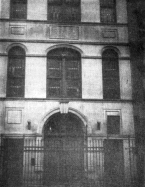The first Grajewo association in New York
was established in about 1890 and had its Shul on Ludlow Street - a building of sweat
shops in which the Shul occupied some floors. The founder of the Shul was Shlomo
Littenberg, one of the first Grajewer immigrants, who was immediately successful
and became a significant cloak manufacturer. He had what could be called a "Grajewer
Shop." As soon as a new immigrant who was a tailor or one who wanted to learn
tailoring came from Grajewo to America, he would be taken immediately to
Littenberg in the shop, where he was Americanized and could look for what to do
next. The Grajewer association was established in his shop, and Littenberg was
its president for a long time. Also active there were: Harris Rotboim and Aharon
Leventhal, who were also later very active in the Grajewer relief committee, in
the aftermath of the First World War - (the first as treasurer, and the second
as vice-chairman); Meyer Wolf, Matish Denemark, Gershon Zumerfeld, Max
Zilbershtein, Willie Grinshtein, Leizer-Hersh Berman, Leizer and Yehuda
Mendelson, Elye Tobias and others. The membership was about 40.
|
|
|
|
 |
|
The Szczuczyner-
Grajewer Shul
242 Henry Street
New York City |
|
| |
|
At the same time the Szczuczyner
compatriots also had an association, bigger than the Grajewer. Its membership
was about 60. On Forsythe Street, they had a bigger Shul than the Grajewer. In
1906, both Shuls united. The Grajewer gave up their Shul and merged with the
Szczuczyner.
From the outset the merger appeared
unsuccessful. Frictions started immediately. The Szczuczyners felt themselves at
home. Their association was bigger and richer, they held onto their home, their
Shul, and their managers from the outset had the best positions and controlled
the most desirable honors and distinguished positions, while the Grajewers, as
"guests," had to be satisfied with behind the bima, with the slimmer honors and
with their fewer and smaller positions.
They soon spoke of separation. The
Grajewers already wanted to separate but the Szczuczyners refused to return the
assets which the Grajewers had invested into the partnership. Both sides brought
the issue to a rabbinical court of three rabbis who ruled in favor of the
Szczuczyners, but they appealed to both sides for peace and living together. The
appeal worked. Immediately after that, there were elections for officers and
both sides got appropriate representation in the administration. Peace was so
cemented that in a few years, in 1910, they decided to build the memorable Shul
on Henry Street.
When they began to build the Shul, the
association had only $1800. When the Shul was completed, it cost over $36,000.
Biggest thanks for the Shul belongs to Mr. Nathan Hammer, himself an experienced
builder who devoted his entire time to finding various resources to make it
possible that the Shul would be completed.
The Shul is not a large one, but surely
one of the most beautiful Shuls on the East Side. In the first years of the Shul's existence, it was not only a holy place in which to pray, but also a
center for celebrations and other occasions. During the time of the First World
War, the Shul was a center for relief activities.
The first president of the new Shul was
Moshe Kronenberg, who held that position two years, and Max Zilbershtein,
vice-president. Then Mr. Harris Rotboim became president. About 20 years later
Yankel Burshtein (son-in-law of Boruch-Mordechai, the bath-house attendant) held
the presidency. He made it his task and actually made it possible to wipe out
the Shul's mortgage.
Almost all those active in the Shul were
workers, toilers, who made it their life-task to support a Grajewer religious
center in New York. Among them: Isaac Kohn, Moshe Goldshtein, Avrohom-Yitzchak
Hammer, Yisroel Kleinman, Aharon-Yankl Weinberg, Itshke Rosen, Gershon Kohn, Max
Zeligzon, Avrohom Abbot, Shmuel Brikman, Yitzchak Alpert, Michl Edelson, Alter
Feinzilber, the brothers Green (of whom Yankel was president), Mattes Gerson and
his children, Moshe Zilbershtein, Max Rotbil and his son Benny.
For a number of years the Shul also had
an active ladies' auxiliary which helped a great deal with relief work. Most
active were Soreh Goldshtein (Soreh Monishes) and Fannie Zilberman.
The current officers of the Shul are:
Moshe Kohn, president; Sam Birnboim, vice president; Annie Fein, secretary; Max
Rozenzweig, treasurer; Yankl Burshtein, manager of the Chevra Kadisha. The new
officers recently bought a new cemetery for $3,000 and spent $6,000 to renovate
the Shul.
|